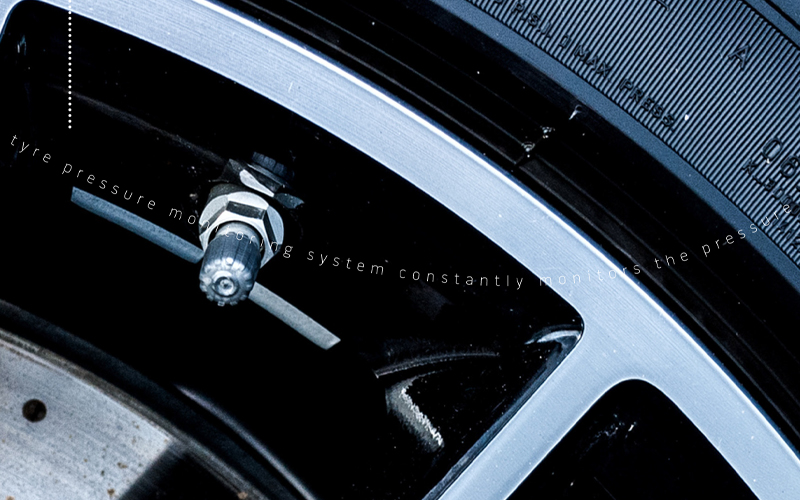What is TPMS
A tyre pressure monitoring system constantly monitors the pressure and temperature of a vehicle’s tyres. If the tyre pressure drops or is below the recommended minimum pressure, the driver is alerted either by an audible signal and/or warning symbol lighting up on the dash, depending on vehicle model.
The TPMS system helps to prevent accidents, improve fuel economy and decrease carbon emissions.
TPMS is now being tested as part of the MOT road worthiness test. At present, any vehicle manufactured before 2012 that has been fitted with a TPMS will receive an ‘advisory’ on their test if a fault is detected or the TPMS dashboard light is illuminated.
This will be recorded on the MOT test certificate. The inspection of the tyre pressure monitoring system (TPMS) is for M1 vehicles first used on or after 1 January 2012.

TPMS and the MOT Test
TPMS and the MOT Test
Indirect TPMS
Indirect TPMS mTPMS is now being tested as part of the MOT road worthiness test. At present, any vehicle manufactured before 2012 that has been fitted with a TPMS will receive an ‘advisory’ on their test if a fault is detected or the TPMS dashboard light is illuminated. This will be recorded on the MOT test certificate.
Indirect TPMS
The inspection of the tyre pressure monitoring system (TPMS) is for M1 vehicles first used on or after 1 January 2012.easures the rotational speeds diagonally of each tyre using the ABS speed sensors. An under-inflated tyre will rotate slower than the correctly inflated one, giving a tyre pressure warning.
Indirect TPMS
The TPMS warning lamp can operate in many ways depending on the vehicle type. You must only reject vehicles if it‘s clear that the lamp indicates a system malfunction and not simply indicating that one or more of the tyre pressures is low. (www.mot-testing.service.gov.uk)
Benefit of TPMS
Increased road safety
The TPMS system is constantly monitoring the pressures
of the tyres. Addressing potential TPMS warnings will
decrease the potential for:
• BLOW OUTS
• AQUAPLANING
• BRAKING DEFICIENCY
fuel consumption.
Correct tyre inflation also leads to optimising miles per
gallon for a vehicle. Driving with under-inflated tyres can
consume more fuel.
Reduces CO2 emissions
Reduces tyre wear
Incorrect pressure in tyres will lead to uneven tyre wear,
meaning the tyres will need replacing sooner.
Avoid MOT failure.
A faulty Tyre Pressure Monitoring System (TPMS) is now an
automatic MOT fail on cars registered after 1 January 2012.
Saves you money
Cheaper to service than full replacement.
Regular maintenance can reduce long term service costs.
Direct or Indirect TPMS – What‘s the difference?
Indirect TPMS
Indirect TPMS measures the rotational speeds diagonally of each tyre using the ABS speed sensors. An under-inflated tyre will rotate slower than the correctly inflated one, giving a tyre pressure warning.
Direct TPMS
Each wheel of the vehicle has a sensor fixed to monitor the changes in pressure from the tyre. If low pressure or a leak is detected (generally 25% less than operating pressure) the driver is alerted by the in-car system.
UK CARS WITH TPMS ARE MADE UP OF:
40% Indirect TPMS
60% Direct TPMS
 |
Indirect TPMS – PROs • The system works from the ABS speed sensors already installed in the vehicle. • It is low cost. • There is no chance of sensors needing to be replaced or being damaged in any tyre related work. |
 |
Indirect TPMS – CONs • It is not accurate. • The system needs to be re-set when tyres are replaced, inflated or positions changed. • It is possible to TRICK the system. For example, four underinflated or flat tyres will not set off a warning as they are still rotating at the same speeds. • A puncture after parking is not identified. |
 |
Direct TPMS – PROs Direct TPMS monitors tyre pressure to 1.5 kpa (Kilopascals) ( 1 bar = 1000 Kpa) so is very accurate. • Sensors send their signal approximately every 30 seconds whilst driving. Low pressure will be identified very quickly. • Tyre sensors can identify leaking air. • At start up a tyre with low pressure is immediately identified. • It can also measure temperature unlike the ABS system. |
 |
Direct TPMS – CONs • More expensive solution. • Requires maintenance. • Requires additional diagnostic equipment to reset and service. |

